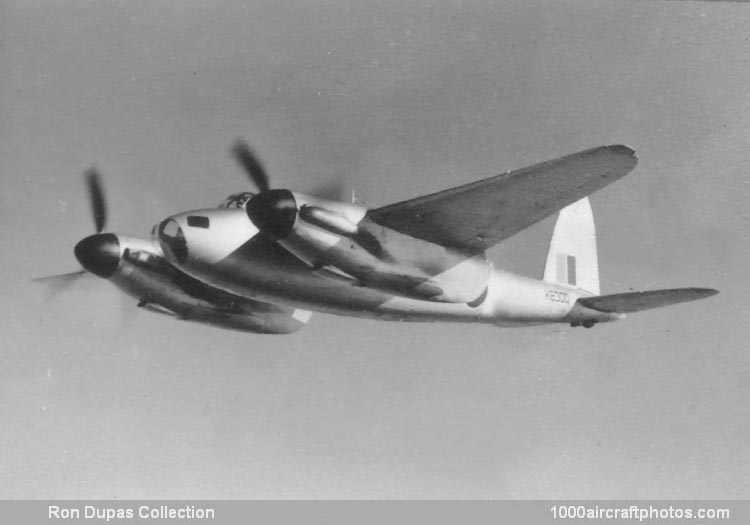12/15/2015. Remarks by Johan Visschedijk: "Even before the war the parent de Havilland company at Hatfield, UK had considered building operational aircraft in Canada and, after Dunkirk, the transfer of its main production to Canada. Fortunately, such a move was not required. With the RAF's acceptance of the Mosquito and consequent large production orders, it was logical to consider a sub-contract for the aircraft to the de Havilland Canada (DHC) company at Downsview, Ontario. In September 1941 an order for 400 Mosquito bombers was placed for delivery beginning in September 1942 and working up to 50 aircraft a month by May 1943. This order was inevitably increased and fighter bombers and trainers were added as the war continued and conditions changed.
At the outbreak of war de Havilland came up with a private proposal to build an unarmed bomber which would rely entirely on its speed to elude the enemy. The Air Ministry discounted the performance estimates and said that it would not work, but one member of the Ministry felt otherwise and through him an order was given for a prototype in December 1939. Even then de Havilland's idea had not been accepted for the type was to be a photographic reconnaissance aircraft. It was not until July 1940 that it was thought that it might be useful as a fighter, and not until July 1941 that it was agreed that it would be useful as an unarmed bomber as de Havilland had originally proposed. The British prototype first flew on 25 November, 1940, and its performance caused the reversal of official opinion.
The Mosquito was built of wood. The fuselage had a double birch ply shell with a balsa core and was molded in two halves, most of the services being installed before joining. The wing also had a double birch plywood skin, separated by spruce stringers. The Canadian Mosquitos all were powered by Packard-built versions of the Rolls-Royce Merlin. The aircraft had a crew of two, a pilot and navigator/bomb-aimer, and carried 647 gal (2,450 l) of fuel in the wings and two 48 gal (182 l) drop tanks. The Canadian drop tanks were of molded plywood, made fuel-tight by an internal plastic coating.
The above pictured prototype first flew from Downsview on September 23, 1942, piloted by George Ralph Spradbrow accompanied by British flight engineer, F.H. Burrell. Geoffrey de Havilland, son of the company's founder, flew KB300 on the 29th and during October gave a series of demonstrations with it at various centers including Ottawa, Washington D.C., and Wright Field, Ohio.
Total Canadian-built Mosquito production was 1,033 but two bombers crashed during testing and were not accepted, but also not replaced. The Canadian-built Mosquito variants were:
B.Mk.VII. Bomber, unarmed. 1,300 hp Merlin 31 engines. As British Mk.IV. Two 60 gal (227 l) drop tanks or two 500 lb (227 kg) bombs under wing. Four 500 lb (227 kg) bombs in bomb bay. 25 built (KB300 to KB324). First acceptance December 30, 1942, last acceptance October 6, 1943.
B.Mk.XX. Bomber, unarmed. 1,300 hp Merlin 31 or 1,390 hp Merlin 33 engines. As British B.Mk.VI but with Canadian/US made instruments and equipment. 245 built. First acceptance May 19, 1943, last acceptance June 8, 1944.
F-8. Photographic reconnaissance aircraft, unarmed. A modification of B.Mk VII and B.Mk.XX for USAF by DHC. Two bomb-bay fuel tanks. Modified oxygen system of increased capacity. Two Fairchild K-17 or K-22 cameras on a split vertical arrangement in forward bomb bay. Provision for a vertical camera in rear fuselage. Seven B.Mk VIIs and 33 B.Mk.XXs were delivered as F-8s. First acceptances June 2, 1943, last acceptances March 20, 1944.
FB.Mk.21. Fighter bomber. 1,300 hp Merlin 31 or 1,390 hp Merlin 33 engines. As B.Mk.XX but with four 0.787 in (20 mm) cannon and four 0.303 in (7.7 mm) Browning guns. Two 500 lb (227 kg) bombs in bomb bay. Two drop tanks or two 500lb (227 kg) bombs under wing. Three built. First acceptance August 31, 1943, last acceptance November 29, 1944.
T.Mk.22. Trainer, unarmed. 1,300 hp Merlin 31 or 1,390 hp Merlin 33 engines. As FB.Mk 21 but with dual controls and unarmed. Four built. First acceptance September 7, 1944, last acceptance February 16, 1945.
B.Mk.25. Bomber, unarmed. 1,620 hp Merlin 225 engines. As B.Mk.XX but with more powerful engines. 400 built. First acceptance July 6, 1944, last acceptance April 16, 1945.
FB.Mk.26. Fighter bomber. 1,620 hp Merlin 225. As FB.Mk.21 but with more powerful engines. 335 built. First acceptance February 6, 1945, last acceptance August 20, 1945.
T.Mk.27. Trainer, unarmed. 1,620 hp Merlin 225. As FB.Mk.26 but with dual controls and unarmed. 21 built. First acceptance February 16, 1945, last acceptance June 6, 1945.
T.Mk.29. Trainer, unarmed. 1,620 hp Merlin 225. Conversion from FB.Mk.26 for training purposes. Sixty conversions made, fifty by Canadian Car & Foundry Ltd, Amherst, Nova Scotia, and ten by Central Aircraft, London, Ontario.
Two survivors of the 1,033 Canadian-built Mosquitos are known. One, a B.Mk.XX, s/n KB336, is in the Canada Aviation and Space Museum at Ottawa, and the other, an FB.Mk.26, s/n KA114, is held by the Military Aviation Museum at Virginia Beach, Virginia, USA and is in airworthy condition, registered as N114KA."
